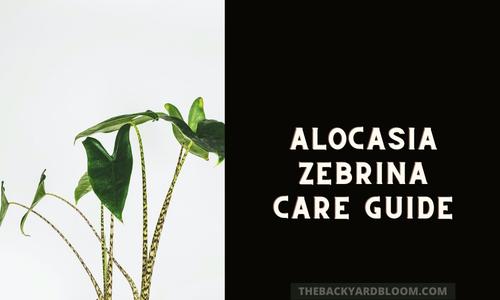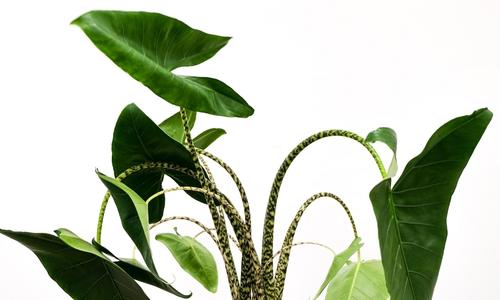Please note that this post may contain affiliate links. You can read my full affiliate disclosure at the bottom of the page.
The Alocasia Zebrina is an indoor tropical plant that is gaining popularity among tropical houseplant collectors. Also called the Zebra plant, it is also one of the Alocasia plants that can be a good introduction to Alocasias for those who are testing the water in caring for these beautiful plants. While the Zebrina was rare a few years ago when it was gaining popularity on the houseplant scene, it has become more common and less expensive. In this care guide, we go over all you need to know in order to take care of an Alocasia Zebrina plant.
Origins
The Alocasia Zebrina originates from the Philippines. There it grows in the tropical forests at low and medium altitudes.
It was originally recognized in 1863 and is now currently listed as a threatened species of Flora in the Philippines.
Specific Varieties of The Alocasia Zebrina:
- Alocasia zebrina ‘Tiger’
- Alocasia zebrina ‘Variegata’
- Alocasia zebrina ‘Reticulata’
- Alocasia zebrina ‘Tigrina Superba’

Quick Overview on How to Care for an Alocasia Zebrina
- Water once the top 2 inches of soil has dried. Do not use tap water.
- Bright indirect light is best.
- Rotate the pot regularly to avoid leaning.
- Well draining aroid soil.
- Use well draining pot.
- Fertilize once a month in the spring and summer at half-strength with a regular houseplant fertilizer.
- Temperatures: 60°F – 80°F
- Humidity: 40% – 70%
Other Alocasia Care Guides:
Alocasia Zebrina Watering
Alocasia Zebrina requires some extra attention to watering. It is best not to try to stick to an exact watering schedule with these plants, instead water them as they need it.
You do not want to overwater them or underwater Alocasias. Allow the top two inches of soil to dry out before giving it more water. But make sure not to let all of the soil in the pot dry out between watering your plant.
Always use filtered, distilled, or rainwater for your Zebrina. Do not water with regular tap water. Chemical additives and hard metals can cause issues with Alocasia plants.
If your Alocasia is in the process of growing new leaves, you will need to water it more often. If you see new growth on the plant, check the soil moisture at least every other day. Without enough water, it is easy to lose the new growth on any Alocasia.
Alocasia Zebrina Light Needs
The Alocasia Zebrina grows best in bright indirect light. It can tolerate some sun, morning or late evening sunlight is best. While it can live in medium light it has been observed in its natural habitat to grow better where it has brighter light.
If you notice that your Zebrina is starting to look leggy or is leaning towards the light source, then you should move it to a location that has more light. Rotating your plant regularly can also help avoid leaning towards the light source.
Alocasia Zebrina Soil
Well-draining soil is best for Alocasia Zebrinas, but also some ability for the soil to retain a bit of moisture. This is important since allowing the plant to completely dry out can cause issues with dropping leaves and losing new growth.
Some options for good soil mixes would be to make your own with equal parts potting soil, orchid bark, perlite, and worm castings. You could also get a premade aroid soil mix.
Size
The Alocasia Zebrina, when mature, can reach 4 to 6 feet in height on average.
Some varieties such as the Alocasia zebrina ‘Tigrina Superba’ can grow up to 10 feet tall.
Pots
What pot you use for your Alocasia Zebrina really depends on your watering style. Always pick a pot that has drainage.
If you tend to overwater, then terracotta would be a good option for your Alocasia. If you underwater your plants, then it would be a good idea to stay away from terracotta pots. You can also use standard ceramic or plastic plant pots if you are diligent about checking soil moisture levels before watering.

Repotting
Alocasia Zebrina plants tend to prefer smaller pots when compared to other plants that are the same size.
It is best to repot your Alocasia in the springtime, right when it is starting to get into its growing season.
Once you see roots coming out of the existing pot then it is time to repot your Zebrina. If your Alocasia is dropping leaves with no signs of pests and watering is being done properly, that could be another indication that it needs to be repotted.
Pick a new pot that is only 1 inch bigger than the current pot. Alocasias don’t respond well to big increases in pot size when repotting.
Fertilizer
During the spring and summer months, fertilize your Alocasia once a month with any all-purpose houseplant fertilizer at half-strength.
If you have just repotted your Zebrina, skip a few months of fertilizing due to the plant food that is in most soil mixes.
Temperature
Alocasia Zebrina plants can tolerate temperatures between 60°F and 80°F. The optimal temperature is a steady 70°F. Do not allow the temperature to drop below 50°F where you keep your plant.
Make sure that your plant is out of the way of drafts from both air conditioners and central heating. If your Zebrina is in a draft it can start to drop leaves.
Humidity
Humidity should be between 40% and 70% will be ok for the Alocasia Zebrina. The optimal humidity level for these plants is 60%.
If you start to see brown edges on your Alocasia, that is usually an indicator that the humidity level is too low and it needs higher levels. Small humidifiers can help increase humidity when placed near your plant. Another option is to use an indoor greenhouse cabinet for your tropical plants.
Too low of humidity levels can also lead to issues with spider mites. So it is important to keep the levels for your plant above 40%.
Alocasia Zebrina Toxicity to Pets
Alocasias are toxic to both cats and dots. Like other tropical plants, they do have oxalate crystals that can be released when they are chewed or bitten.
Alocasia Zebrina Problems
Dirty Leaves
With the shape and size of the leaves, these plants can get a buildup of dust easily. Every other time that you water your Alocasia Zebrina, wipe down the leaves with a damp rag. Only use water to clean off the leaves.
Spider Mites
One of the most common pests that people get on an Alocasia is spider mites.
If you have an issue with them on your Zebrina, it can be that the humidity levels are too low. Spider Mites don’t like moisture. Keeping the humidity levels up can help keep these pests away.
You can use neem oil to help get rid of these pests or also spray the plant with filtered water since moisture will force the mites to go elsewhere.
It is a good idea to periodically check the leaves for spider mites, you can easily do this when you wipe down the leaves of the plant.
Yellow Spots on the Leaves
Alocasia Zebrina plants can get yellow spots on the leaves due to inconsistent watering. If you let the plant get overwatered and then underwatered regularly yellow spots will start to develop on the leaves.
Yellow Leaves
Yellowing leaves indicate that your Alocasia is overwatered. Cut back on the watering frequency and amount. Changing the soil to a more barky mix can help keep from too much moisture building up in the soil. Also, make sure that you have a pot that has drainage. Switching to a terracotta pot could also be another option to help avoid overwatering.
Brown Tips
Brown tips on the leaves of an Alocasia Zebrina indicate that the plant is underwatered.
Check your plant soil moisture levels more often. If you are using a terracotta pot, think about switching to a ceramic or plastic pot to avoid allowing the soil to dry out so fast.
Brown Edges
Brown edges all the way around the leaves are another indication that the humidity levels are too low for your plant. You can get a small humidifier to help raise the humidity near the plant or use an indoor greenhouse to help keep humidity levels high.
REFERENCES:
- Alocasia; Pet Poison Helpline; https://www.petpoisonhelpline.com/poison/alocasia/
- Alocasia zebrina Veitch ex J.Dix; Royal Botanic Gardens Kew; https://powo.science.kew.org/taxon/77177187-1
- Role of light in the life stages of mt. makiling populations of alocasia zebrina; UPLB University Repository; https://www.ukdr.uplb.edu.ph/journal-articles/2081/
- Alocasia (Alocasia zebrina); The National Gardening Association: https://garden.org/plants/view/120853/Alocasia-Alocasia-zebrina/
- Alocasia zebrina ‘Tigrina Superba’; The National Gardening Association; https://garden.org/plants/view/661132/Elephants-Ear-Alocasia-zebrina-Tigrina-Superba
- National List of Threatened Flora; https://bmb.gov.ph/index.php/facts-and-figures-wild/national-list-of-threatened-flora